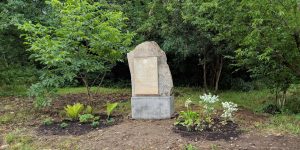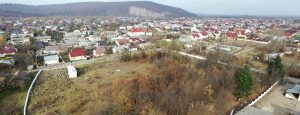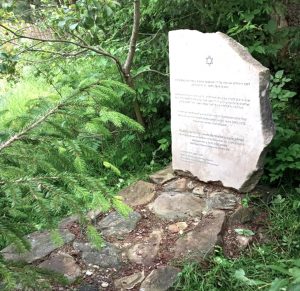![]() Ця сторінка також доступна українською.
Ця сторінка також доступна українською.
Introduction
This page summarizes and analyzes a project which created and installed a memorial monument on the grounds of the Jewish cemetery of Nadvirna in the Nadvirna raion of the Ivano-Frankivsk oblast in western Ukraine. The marker was conceived to stand in for the missing matzevot of the thousands of Jews killed just outside Nadvirna or deported and killed elsewhere during the Shoah, who have no individual stones and epitaphs in their name. This project coordinates directly and indirectly with several other projects managed by the same activists, plus other individuals and organizations, at the same site and other sites in western Ukraine.
This page is intended as a reference for similar projects now in the planning stages in western Ukraine or beyond. Following a brief summary of the site, the material below describes the project and reviews its effectiveness together with a listing of issues encountered, approximate project costs, and ongoing risks. Related projects both in western Ukraine and elsewhere in Europe are also briefly mentioned, for comparison. At the bottom of this page are links to project documentation and to additional reference information about the burial site and related projects.
Read the overview to case studies of selected projects at Jewish burial sites in western Ukraine.
Project Summary
Project type: Creation and installation of a stone and plaque commemorating the Nadvirna Jewish community killed during the Holocaust.
Location and site type: Jewish cemetery of Nadvirna, Nadvirna raion, Ivano-Frankivsk oblast, Ukraine. Cemetery GPS: 49.41990, 24.60780. Memorial monument GPS: 48.63688 24.57741 (across Vyzvolennia Street from No. 31).
Description of the site: The original cemetery perimeter is nearly rectangular in shape and of approximately 600m length, enclosing roughly 2.4 hectare of area, on a nearly-flat site; a portion of the original cemetery is overbuilt with industrial buildings. The monument is located at the north corner of the cemetery grounds, outside the main fence and wall, facing the turn of the road.
Ownership and stakeholders: The cemetery site is owned by the municipality of Nadvirna. Stakeholders include the Nadworna Shtetl Research Group (NSRG, an online group begun in 2014 of more than 120 Jewish descendants of survivors and prewar emigrants from Nadvirna), the local civil community, other descendants of Nadvirna pre-war Jewish and other families, historians, and students of Jewish culture.
Official heritage status: Unknown.
Activists working on/at the site: Nadworna Shtetl Research Group (NSRG), a global organization led by Dr. Steven Turner and based in New York City, USA (contact info); Leslie Nolan, a US Peace Corps Volunteer based in Nadvirna at the time of the project work; Volodomyr Hrynishak, director of the Nadvirna Tourist Information Center (contact info); all working as volunteers.
Other projects active at the site: Digital documentation of the cemetery terrain (see ESJF 2019 survey project); digital documentation of the cemetery headstones and the Jewish community (see JGB 2010 photographs and epitaphs field school); clearing and fencing of the open portions of the cemetery perimeter (see ESJF 2019 fencing project page); occasional additional cemetery clearings by Jewish research organizations and local contractors. An earlier, Soviet-era memorial monument also exists in the Bukovynka forest outside of Nadvirna, at the site of a Jewish mass grave from the Shoah period, at GPS: 48.62017 24.59534 (see Yahad – In Unum research project).
Project Analysis
History of the site: The Pinkas Hakehillot Polin chapter on Nadwórna and research by Jewish Galicia and Bukovina (JGB) indicate that the Jewish community of Nadvirna was established before or during the 17th century and grew substantially in the 18th century. Based on surviving documented headstones, the Jewish cemetery was established already by the beginning of the 18th century, and probably began in the prior century. JGB headstone documentation indicates that the cemetery was in continuous use at least until 1940 (under Soviet occupation during WWII). Research in 1996 by Yuriy Isaakovich Khodorkovskiy for the US Commission (now IAJGS International Jewish Cemetery Project) indicates that the cemetery was vandalized during World War II (including the theft of matzevot) and occasionally since; Khodorkovskiy also records a vegetation clearing project by Ukrainian and foreign Jews in 1996. JGB organized another clearing in 2010 ahead of their documentation project, but an online article by Edgar Hauster in 2013 showed that the vegetation had already begun to impede walking; a 2017 visit by Christian Herrmann and others showed that trees had been removed in a prior year but high grass and nettle made the site nearly inaccessible.
The Jewish community of Nadvirna suffered some of the earliest and most devastating killings and deportations in German-occupied eastern Galicia, beginning with an October 1941 massacre and burial in the Bukovynka forest outside of Nadvirna. In an unknown year after the war, a Soviet-style obelisk memorial was installed at the site carrying a brief inscription in Ukrainian language identifying the place where nearly 4000 “Soviet citizens” were shot and buried. A second sign in Hebrew states the monument was erected by Rabbi Israel Meir Gabbai, and says that those murdered were Jews and that the massacre was on Yom Kippur, although survivor accounts recorded in the Yizkor Book for Nadworna date the event on the eve of the holiday of Sukkot.
Current features of/at the site: The cemetery is situated adjacent to main roads on two sides, with residences and gardens adjacent to a third side, and most of the fourth side encroached and overbuilt by industrial buildings. The cemetery entrance is near the east corner of the territory. In the middle 2010s the two ohels near the front of the cemetery were rebuilt and the tsadiks’ grave monuments inside rehabilitated. Surveys of the headstones which remain in the cemetery have reported varying numbers; the detailed survey conducted by JGB in 2010 databased nearly 250 intact stones but the field school report from the same year reports 530 stones were photographed and transcribed. Aerial video from the 2019 ESJF drone survey following an extensive clearing of wild vegetation in the cemetery shows a hundred or more toppled or uprooted headstones at the site, together with isolated groups of intact or uprighted headstones representing what is probably a small fraction of the prewar collection of matzevot. The cemetery has been partially enclosed with a wall and light fencing for the past decades; a new fence along the front (northwest) side plus improvements to the existing wall and fencing on other sides were installed by ESJF with financial support from the NSRG in 2019. Large trees cover about half the cemetery terrain.
Details of the project: The initiative and concept for the project came from the NSRG, led by Dr. Turner. The memorial site was researched and selected by Rabbi Kolesnik of Ivano-Frankivsk as highly visible in Nadvirna and associated with existing places of Jewish memory (the cemetery and an unmarked mass grave of ghetto victims). The monument was constructed by local artisans after research by Ms. Nolan and Mr. Hrynishak, discussions within the NSRG, development of the text to be placed, translations, and a considerable amount of coordination in Nadvirna by Ms. Nolan and Mr. Hrynishak.
The completed memorial monument stands about 1.8m tall overall, including a single 1.3m-high stone 0.5m-high concrete base; the stone and base footprint is roughly 0.8m wide and 0.6m deep. The base rests on a large foundation stone dug into the soil, flush with the ground surface. A tapered layer of decorative stone is mortared to the concrete base to provide visual stability. The large main stone is carved with a recess for the plaque. The plaque is a decorative stone plate etched to raise the text and a Star of David emblem; the raised features are painted to provide visual contrast for legibility.
The text of the inscription is in four languages: Hebrew, Yiddish, English, and Ukrainian. The text reads, “In eternal memory of our ancestors murdered in Nadworna by Nazi Germans and their collaborators in the years 1941-1942. May their memory be blessed.” The plaque is dated for the dedication ceremony and signed by the NSRG.
A dedication ceremony was held at the site on 12 August 2018 in the presence of more than a dozen members of the NSRG including Dr. Turner, plus Rabbi Kolesnik, Ms. Nolan, Mr. Hrynishak, and local citizens. After the monument had been placed and before the dedication ceremony, nearby residents offered and planted decorative plants on both sides of the installed memorial, to dress the site for the event.
Issues encountered in the project: Several material and process quality issues slowed the project and/or required remedial work after installation. The concrete block base was originally placed directly on the site soil, without a proper foundation for stability; after the dedication, the monument was removed temporarily and then reset on a large foundation stone placed in an excavated hole. The cement used to attach the plaque to the monument stone failed a few weeks after the dedication and the plaque fell off; it was re-glued and mechanically fastened with better materials the following spring. The plaque inscription as originally etched was difficult to read because of a lack of contrast between the characters and the background; an artist was hired to paint the raised letters with a contrasting color, significantly improving legibility. Agreement among descendants on the brief text for the inscription required much discussion, and the translations introduced language nuances which required further revision and agreement among the stakeholders.
Project costs, one-time and sustaining: The preliminary estimate of construction and installation costs for the complete memorial (main stone, inscribed decorative stone plaque, concrete base, and labor) was about US$900. The final cost after design adjustments and post-installation repairs and reworking was less than US$1200. Funding for the project was donated largely by members of the NSRG, with a supplemental donation by Dr. Turner. Half of the original estimate was paid in advance (via Western Union) with the remainder paid in cash on completion at the dedication ceremony. Adjustments and repairs in the first year after completion were included in the total cost; funds have not been allocated for future repairs but the NSRG continues to monitor the memorial and the site. Prior to Ms. Nolan’s departure from Nadvirna at the end of her Peace Corps term, she made an introduction between Nadvirna resident Tetiana Yavirnytska and Dr. Turner; Ms. Yavirnytska was retained to look after the property and conduct business in the town as needed for the NSRG.
Current risks to preservation: With the completion of the street-side wire fence by ESJF in 2019, the memorial monument is now protected from street traffic and accidental damage. Dr. Turner reports that cemetery neighbors appreciate the memorial and will likely monitor it for weathering and other decay; Mr. Hrynishak of the town’s tourist information center along with neighbor Igor Osypenko are also monitoring the cemetery and the memorial as heritage assets of Nadvirna. Because the inscription text and emblem were painted to improve legibility, it is likely that the paint will need to be refreshed from time to time. Past experience at the site indicates that both the cemetery and its surroundings will see rapid wild vegetation growth in the next years, necessitating future clearing and maintenance projects.
Related projects in western Ukraine: Like the project in Nadvirna, many Jewish memorials in towns and villages in western Ukraine are initiated and funded by foreign Jews, often with the support of plus local coordination and construction by area officials and interested citizens; some are almost entirely created by non-Jewish locals. Inspired by the results of the project in Nadvirna, and consulting with Leslie Nolan on strategy and process, NSRG member Darcy Stamler engaged Ms. Yavirnytska to create a memorial at a mass shooting site in the neighboring town of Mykulychyn. While the majority of Jewish cemeteries and killing sites currently lack memorial monuments, examples exist at Velyki Mosty and Yavoriv (Lviv oblast); Bilshivtsi, Deliatyn, and Rohatyn (Ivano-Frankivsk oblast); Katerynivka, Pidhaitsi, and Tovste (Ternopil oblast); plus at many others. Few of the monuments and memorial sites have any form of internet presence; images are primarily available on local journalism websites and specialist blogs.
Related projects outside western Ukraine: Local and/or national administrations have worked with descendants and local citizens to erect memorials at Jewish cemeteries and mass grave sites in larger central and eastern cities of Ukraine, e.g. at Babyn Yar in Kyiv as well as in Odesa, Mohyliv-Podilskyi, and Kamenets-Podilsky. Similarly, officials and family representatives have worked with local citizens at some sites in smaller towns outside of Ukraine, including at Dubăsari and Soroca in Moldova; Tyniec, Markuszów, and Piotrków Trybunalski in Poland; Düsseldorf in Germany; and at the Père Lachaise cemetery in Paris, France, among many others. Memorial monuments range from modest commemorations, often in stone, to much larger sculpted shapes in concrete, metal, or other materials.

Jewish memorials in western Ukraine, including from left: the cemetery in Bilshivtsi, the mass grave in Deliatyn, the mass grave in Katerynivka, the mass grave in Yavoriv, and the mass grave in Velyki Mosty. Photos © RJH.

Jewish memorials in eastern, central and western Europe, including from left: the mass grave at Babyn Yar, the cemetery in Düsseldorf, the mass grave in Dubăsari, the cemetery in Mohyliv-Podilskyi, the cemetery in Markuszów, and the cemetery in Piotrków Trybunalski. Photos © RJH.
References
- Nadworna Shtetl Research Group (NSRG) – genealogical information about the Jewish families of Nadvirna, historical references and articles, heritage travel and project reports and photos; see especially the page on the Group Tour to Nadworna 2018, which includes many photos of the dedication event, the site, the participants, and the town
- Nadvirna Jewish Cemetery – terrain measurements and survey notes by ESJF European Jewish Cemeteries Initiative
- Nadvirna – Jewish cemetery fencing project data and images by ESJF European Jewish Cemeteries Initiative
- Nadworna Cemetery – the cemetery documentation project page on the Jewish Galicia and Bukovina website
- Nadvirna (Nadwirna, Nadvorna) – research summary on the execution of Jews from Nadvirna by Yahad – In Unum
- Nadvirna – the cemetery research and survey page on the website of the IAJGS International Jewish Cemetery Project
- Jewish Cemetery in Nadvirna (Nadwórna) – the 2010 cemetery photographs and documentation page in the web database of the Center for Jewish Art; see also photos from 2009 before clearing and from 2010 during clearing
- Holocaust Memorial in Nadvirna (Nadwórna) – the 2009 mass grave memorial photographs and documentation page in the web database of the Center for Jewish Art
- Nadwórna Center Field Sketch 1847 – a highly detailed historical property map of the town from a survey during the Austrian era, showing the Jewish cemetery and many other town features, from map panels preserved by the Central State Historical Archive in Lviv (TsDIAL) and presented by Gesher Galicia
- Time-Traveling Between Ivano-Frankivsk and Chernivtsi – a photo and text essay from 2017 covering the Nadvirna Jewish cemetery and other nearby sites, from Christian Herrmann’s Vanished World blog site









